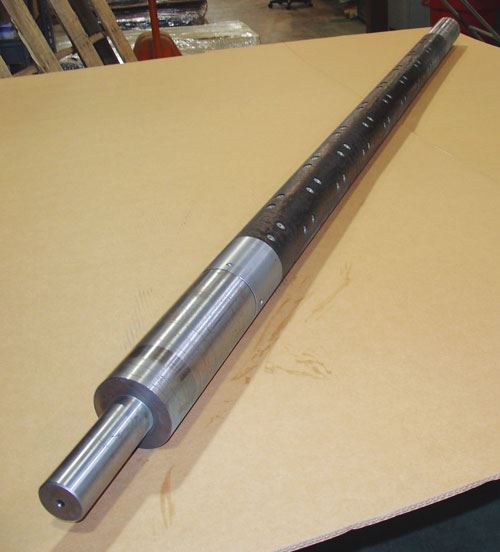New packaging machine uses lightweight carbon fiber airshafts
When Premier Paper Converting Machinery (New Berlin, Wis.) introduced its new custom machine for producing Kraft paper honeycomb used to make packaging materials, the device was equipped to hold four massive 98-inch/2.4m wide rolls of paper, each one weighing 5,300 lb/2,409 kg. To support these paper rolls during u
When Premier Paper Converting Machinery (New Berlin, Wis.) introduced its new custom machine for producing Kraft paper honeycomb used to make packaging materials, the device was equipped to hold four massive 98-inch/2.4m wide rolls of paper, each one weighing 5,300 lb/2,409 kg. To support these paper rolls during unwinding, stiff and lightweight carbon/epoxy "airshafts" were required. The airshafts were filament wound by Nim-Cor Inc. (Nashua, N.H.), which also provides airshafts in steel, aluminum and metal alloys and related core chuck products.
An airshaft, also known as an expanding core shaft, is a hollow metallic or composite tube with metal end journals and bearings that fit into the converting machine. Inside the tube is an elastomeric bladder that, when inflated pneumatically, causes lugs or "buttons" to pop outward from the tube wall to form protuberances. The extended buttons firmly grip the inner core of the paper roll so that the paper can be smoothly unwound by the machine (button holes can be seen in the tube photo). When empty paper rolls need to be replaced, air pressure in the bladder is released, the buttons retract and the airshaft can be pulled easily from the roll.
Kevin Hellrigel, general manager at Nim-Cor, says that the filament-wound composite tubes are custom designed to meet load requirements for each customer application. Stress analysis helps determine tube wall thickness, winding angle and fiber modulus to minimize tube deflection under load. Hellrigel explains that the tubes incorporate carbon fiber tows with differing moduli to optimize tensile strength in key locations. The company produces the tubes in-house, using a wet-winding fabrication method. A finished 100-inch/2.5m composite airshaft weighs only 140 lb/64 kg, light enough for two workers to handle.
"Composite shafts are a growing part of our business," notes Hellrigel, "especially for these types of unique and challenging applications."
Related Content
-
Plant tour: BeSpline/Addcomp, Sherbrooke, QC, Canada
Composites automation specialist increases access to next-gen technologies, including novel AFP systems and unique 3D parts using adaptive molds.
-
Plant tour: Aernnova Composites, Toledo and Illescas, Spain
RTM and ATL/AFP high-rate production sites feature this composites and engineering leader’s continued push for excellence and innovation for future airframes.
-
The potential for thermoplastic composite nacelles
Collins Aerospace draws on global team, decades of experience to demonstrate large, curved AFP and welded structures for the next generation of aircraft.







.jpg;maxWidth=300;quality=90)





